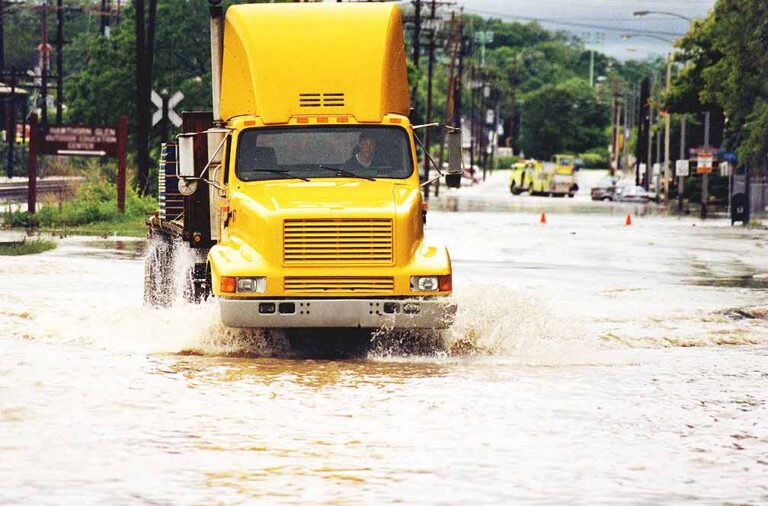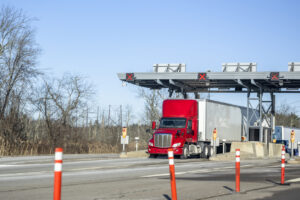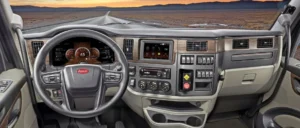AVON, Ohio — The devastating floods in Florida resulting from Hurricane Ian will require massive relief and rebuilding efforts — many of which depend on the trucking industry and thousands of truck drivers.
For commercial vehicles exposed to these types of floodwaters, Bendix Tech Tips is providing fleets and drivers with technical advice on inspecting and possibly reconditioning air brake, wheel-end and other safety components that have been partially or completely submerged.
Saltwater vs. freshwater
The first determination to make is whether the water that affected the vehicle was saltwater or freshwater. If it was salt water, drivers will need to immediately begin replacing parts due to saltwater’s extreme corrosivity, which can remove lubrication and put certain parts at much higher risk for unexpected and premature malfunction. Any brake system valve that has been submerged in saltwater must be replaced. In addition, systems and components, including air compressors, air reservoirs, anti-lock brake system relays, modulators and brake actuators, must also be replaced
“Saltwater corrosion is also a threat to wheel-ends, since it increases the likelihood of rust jacking and accelerates corrosion of critical surfaces,” said Randy Salvatora, engineering manager at Vehicle Systems. “So, we recommend complete replacement of the foundation brakes to prevent a potential future failure. And if it’s not clear whether the water was fresh or salt, play it safe and follow the saltwater guidelines.”
Additionally, when replacing any pneumatic system components that have been subjected to flood conditions, disconnect all contaminated air tubes and hoses, flush them with clean water and blow them out with air pressure to remove contaminants.
Freshwater damage guidelines
If a driver is certain the power unit or trailer was submerged in freshwater, they can begin by carefully power-washing the vehicle, including the foundation brakes. Drivers should note that rubber parts and sealing interfaces should not be directly sprayed with the high-pressure jet, as irreparable damage to valves can occur when a high-pressure washer directly sprays exhaust ports. Appropriate PPE (personal protective equipment) is recommended while washing or working on flooded vehicles, whether saltwater or fresh. In the unapplied state, most valves have the delivery open to atmosphere at the exhaust port, so if any exhaust port is submerged, the water has infiltrated the system and can lead to future malfunction.
Do not attempt to start a vehicle if freshwater has entered the air compressor or dryer through the air system intakes.
Follow these steps to thoroughly check the various parts of the air brake system:
Vehicle valving
- Inspect each component in the pneumatic brake and accessory systems.
- Drain any pressure remaining in the service reservoirs.
- Mark and remove all pneumatic and electrical connectors at each valve.
- Check for evidence of water or contamination inside the connectors, air hoses, or the component itself.
- Carefully use dry compressed air pressure (from a stationary compressor or similar) to blow air through the pneumatic tubes and hoses. Watch for evidence of water or contamination.
- If water or contamination is found inside the component, replace the component.
- If no evidence of water or contamination is found inside the component, reassemble the component to the associated lines and fittings.
- Drivers should repeat this process as they continue to inspect all the valves in the air brake system. Replace any non functioning valves or those showing evidence of ingestion of water or contaminants.
- Inspect tractor and trailer glad hands and the supply and control hoses. Water and contaminants frequently enter the air brake system through unprotected glad hands.
Charging system
- Inspect the air intake, compressor, and air dryer for signs of water or contaminant ingestion.
- Carefully use dry compressed air pressure (from a stationary compressor or similar) to blow air through the pneumatic tubing and watch for evidence of water or contamination.
- Use dry compressed air from a stationary air compressor (or suitable portable unit) to get any residual water out of the service tanks.
- Air dryers remove moisture in compressed air, but they will not remove moisture that’s present in the system beyond the service tanks.
- After reconnecting pneumatic lines, install a new or properly serviced air dryer to aid in removing any residual moisture from the air inlet.
If a driver finds signs of moisture or other contamination, all the pneumatic air brake components should be replaced. Once water or contaminants get into any of the air brake components, it’s impossible to completely clear the system without total disassembly. Consider also the guidance included in the TMC Recommended Practice 617A for contaminant elimination procedure for tractor, trailer, or dolly air brake systems.
Wheel-ends and electronics
Examine all wheel-ends for water, which increases the possibility of corrosion between drum brake lining material and the shoe table (rust jacking). Water can also pool in drums when left standing, increasing the risk of corrosion. Drivers will need to check the integrity of the friction couple between the friction and disc or drum. Water-filled loading docks may not immediately come to mind as “flood events,” but can certainly have the same impact to some wheel-end components such as slack adjusters.
Remove any fittings and mounting stud nuts, and orient ports downward to verify that no water has entered brake chambers through the air lines. If water is present, replace the actuator. Follow the appropriate wheel-end relubrication procedures, including re-greasing slack adjusters.
Assess the braking/safety electronics components using a tool such as Bendix ACom PRO software to conduct a diagnostic download on systems such as ABS, ESC (electronic stability control), and collision mitigation controllers, including any front or side radar units. Electronics will validate through self-check in most cases. If the electronic control unit (ECU) is operable, it will check the necessary solenoids, sensor, harnesses, etc. Make sure to inspect the seven-pin electrical connector interface between the tractor and trailer as well.
For more detailed information, two Bendix Technical Bulletins are available in the Bendix Document Library at bendix.com that serve as valuable resources for getting tractors and trailers back into service after they’ve been submerged:
- Flood Damage: Bendix Recommended Procedure for Trailer and Dolly Control Systems That May Have Been Submerged (TCH-003-048)
- Flood Damage: Bendix Recommended Procedure for Power Vehicles That May Have Been Submerged (TCH-003-049)
Back on the road and follow-up support
If a driver check turns up no evidence of water or contamination, conduct a thorough test of the air brake system and ABS before returning the vehicle or trailer to service. Note that, between the floodwaters and power-washing, it’s possible that ABS wheel speed sensors may have been moved from their normal position. Push them back into contact with the exciter ring by hand, and when the wheel turns, normal wheel-bearing play will adjust the sensor position.
“We recommend retesting and diagnostic checks of the electronic systems after the initial post-flood testing,” Salvatora said. “Additionally, make sure you’re following other vehicle and system manufacturers’ guidelines: Flooding can have bumper-to-bumper effects, and you can’t be too careful.”
Other Bendix support resources include 1-800-AIR-BRAKE, its Service Engineering team, and a library of Service Data Sheets and Technical Bulletins.
The Trucker News Staff produces engaging content for not only TheTrucker.com, but also The Trucker Newspaper, which has been serving the trucking industry for more than 30 years. With a focus on drivers, the Trucker News Staff aims to provide relevant, objective content pertaining to the trucking segment of the transportation industry. The Trucker News Staff is based in Little Rock, Arkansas.















